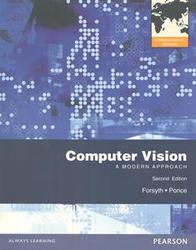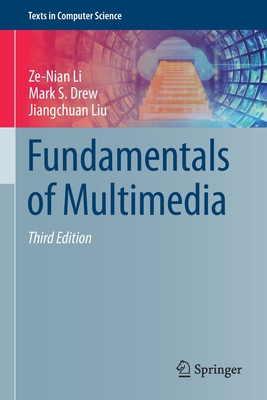Computer Vision: Algorithms and Applications (Hardcover)
暫譯: 電腦視覺:演算法與應用(精裝版)
Richard Szeliski
- 出版商: Springer
- 出版日期: 2010-10-19
- 定價: $2,800
- 售價: 6.0 折 $1,680
- 語言: 英文
- 頁數: 812
- 裝訂: Hardcover
- ISBN: 1848829345
- ISBN-13: 9781848829343
-
相關分類:
Computer Vision
-
相關翻譯:
電腦視覺-演算法與應用 (Computer Vision: Algorithms and Applications) (簡中版)
-
其他版本:
Computer Vision: Algorithms and Applications 2/e (Hardcover)
買這商品的人也買了...
-
 Multiple View Geometry in Computer Vision, 2/e (美國原版)
Multiple View Geometry in Computer Vision, 2/e (美國原版)$4,400$4,180 -
 深入淺出 Java 程式設計, 2/e (Head First Java, 2/e)
深入淺出 Java 程式設計, 2/e (Head First Java, 2/e)$880$695 -
 系統分析與設計 (Essentials of Systems Analysis and Design, 3/e)
系統分析與設計 (Essentials of Systems Analysis and Design, 3/e)$600$474 -
 程式設計師的自我修養-連結、載入、程式庫
程式設計師的自我修養-連結、載入、程式庫$580$458 -
 ASP.NET 4.0 專題實務-使用 C#
ASP.NET 4.0 專題實務-使用 C#$750$593 -
 Google Android SDK 開發範例大全, 3/e
Google Android SDK 開發範例大全, 3/e$950$751 -
 一定要學會的 HTML5 + CSS3 網頁設計實作應用
一定要學會的 HTML5 + CSS3 網頁設計實作應用$450$351 -
 Eclipse 完全攻略-從基礎 Java 到 PDE 外掛開發
Eclipse 完全攻略-從基礎 Java 到 PDE 外掛開發$600$468 -
 Google Android 應用程式開發實戰, 3/e (適用 Android SDK 2.x/3.x)
Google Android 應用程式開發實戰, 3/e (適用 Android SDK 2.x/3.x)$680$537 -
 Android 技術內幕-探索 Android 核心原理與系統開發
Android 技術內幕-探索 Android 核心原理與系統開發$580$458 -
 深入淺出 Python (Head First Python)
深入淺出 Python (Head First Python)$780$616 -
24 小時不打烊的雲端服務-專家教你用 CentOS 架設萬年不掛的伺服器
$680$530 -
 Android 4.X 手機/平板電腦程式設計入門、應用到精通, 2/e (適用 Android 1.X~4.X)
Android 4.X 手機/平板電腦程式設計入門、應用到精通, 2/e (適用 Android 1.X~4.X)$520$411 -
 版本控制使用 Git (Version Control with Git: Powerful Tools and Techniques for Collaborative Software Development)
版本控制使用 Git (Version Control with Git: Powerful Tools and Techniques for Collaborative Software Development)$580$458 -
 App 程式設計入門-iPhone、iPad, 2/e
App 程式設計入門-iPhone、iPad, 2/e$490$387 -
 《超強圖解》前進 Android Market!Google Android SDK 實戰演練, 2/e (適用2.X/3.X/4.X)
《超強圖解》前進 Android Market!Google Android SDK 實戰演練, 2/e (適用2.X/3.X/4.X)$750$593 -
 iOS 創意程式設計家─ iPhone + iPad 跨平台通用, 3/e
iOS 創意程式設計家─ iPhone + iPad 跨平台通用, 3/e$580$458 -
 笑談軟體工程:敏捷開發法的逆襲-導入 Scrum,讓你的軟體開發人生從黑白變彩色!
笑談軟體工程:敏捷開發法的逆襲-導入 Scrum,讓你的軟體開發人生從黑白變彩色!$550$435 -
JavaScript & jQuery: The Missing Manual 國際中文版, 2/e
$580$458 -
 個資保護 1.0
個資保護 1.0$300$270 -
 Computer Vision: A Modern Approach, 2/e (IE-Paperback)
Computer Vision: A Modern Approach, 2/e (IE-Paperback)$1,250$1,225 -
 無瑕的程式碼 - 敏捷軟體開發技巧守則 (Clean Code: A Handbook of Agile Software Craftsmanship)
無瑕的程式碼 - 敏捷軟體開發技巧守則 (Clean Code: A Handbook of Agile Software Craftsmanship)$580$452 -
 $3,135Computer Vision: Models, Learning, and Inference (Hardcover)
$3,135Computer Vision: Models, Learning, and Inference (Hardcover) -
 C++程式設計實務-立即擁有物件導向設計能力的16堂課
C++程式設計實務-立即擁有物件導向設計能力的16堂課$520$406 -
 Deep Learning (Hardcover)
Deep Learning (Hardcover)$1,650$1,617
相關主題
商品描述
Humans perceive the three-dimensional structure of the world with apparent ease. However, despite all of the recent advances in computer vision research, the dream of having a computer interpret an image at the same level as a two-year old remains elusive. Why is computer vision such a challenging problem and what is the current state of the art? Computer Vision: Algorithms and Applications explores the variety of techniques commonly used to analyze and interpret images. It also describes challenging real-world applications where vision is being successfully used, both for specialized applications such as medical imaging, and for fun, consumer-level tasks such as image editing and stitching, which students can apply to their own personal photos and videos. More than just a source of “recipes,” this exceptionally authoritative and comprehensive textbook/reference also takes a scientific approach to basic vision problems, formulating physical models of the imaging process before inverting them to produce descriptions of a scene. These problems are also analyzed using statistical models and solved using rigorous engineering techniques Topics and features: structured to support active curricula and project-oriented courses, with tips in the Introduction for using the book in a variety of customized courses; presents exercises at the end of each chapter with a heavy emphasis on testing algorithms and containing numerous suggestions for small mid-term projects; provides additional material and more detailed mathematical topics in the Appendices, which cover linear algebra, numerical techniques, and Bayesian estimation theory; suggests additional reading at the end of each chapter, including the latest research in each sub-field, in addition to a full Bibliography at the end of the book; supplies supplementary course material for students at the associated website, http://szeliski.org/Book/. Suitable for an upper-level undergraduate or graduate-level course in computer science or engineering, this textbook focuses on basic techniques that work under real-world conditions and encourages students to push their creative boundaries. Its design and exposition also make it eminently suitable as a unique reference to the fundamental techniques and current research literature in computer vision.
商品描述(中文翻譯)
人類輕鬆地感知世界的三維結構。然而,儘管計算機視覺研究最近取得了許多進展,讓計算機以與兩歲小孩相同的水平解釋圖像的夢想仍然難以實現。為什麼計算機視覺是一個如此具有挑戰性的問題?目前的技術狀態又是什麼?《計算機視覺:演算法與應用》探討了用於分析和解釋圖像的各種常用技術。它還描述了在現實世界中成功應用視覺的挑戰性案例,包括專業應用如醫學影像,以及學生可以應用於自己個人照片和視頻的有趣消費級任務,如圖像編輯和拼接。這本極具權威性和全面性的教科書/參考書不僅僅是“食譜”的來源,還以科學的方法探討基本的視覺問題,通過建立成像過程的物理模型,然後反轉這些模型以生成場景的描述。這些問題還使用統計模型進行分析,並通過嚴謹的工程技術來解決。
主題和特點:結構設計以支持主動課程和項目導向的課程,並在導言中提供使用本書於各種自訂課程的建議;每章結尾提供練習題,重點強調測試演算法,並包含許多小型期中項目的建議;附錄中提供額外材料和更詳細的數學主題,涵蓋線性代數、數值技術和貝葉斯估計理論;每章結尾建議額外閱讀,包括每個子領域的最新研究,並在書末提供完整的參考書目;為學生提供補充課程材料,網址為 http://szeliski.org/Book/。本教科書適合計算機科學或工程的高年級本科生或研究生課程,專注於在現實世界條件下有效的基本技術,並鼓勵學生突破創意的界限。其設計和闡述也使其成為計算機視覺基本技術和當前研究文獻的獨特參考資料。













